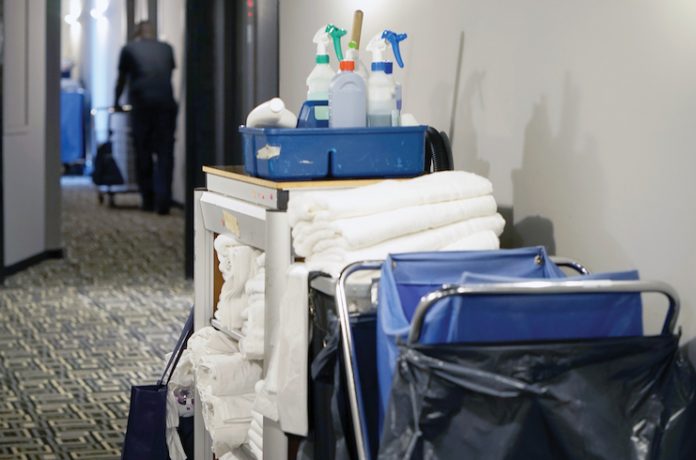The pandemic has affected all aspects of hotel operations, including cost allocation and staffing practices. With labor remaining a moving target for the industry, STR’s monthly profitability data for the United States reflects many of the trends and tactical changes that have been discussed during recent conferences—and likely, internal strategy meetings.
In 2019, labor costs were split on average into 71 percent wages and 29 percent benefits, which is closely in line with the annual average reported by the U.S. Bureau of Labor Statistics (70.1 percent and 29.9 percent, respectively). During 2020, most hotels had to reduce their staffing levels to match the decrease in room and meeting space demand. By reducing employee hours, hotels were able to reduce salary costs, but with furloughs, they still covered benefits as usual. The direct impact of lockdowns, staffing reductions, and furloughing was reflected in April 2020, with a sharp increase in benefits costs to 47 percent of total labor and wages dropping to 53 percent.
Wages allocation jumped back to 73.5 percent in 2021, a result of hotels reopening, but the competitiveness in the talent acquisition landscape also grew, as did the effects of inflation. Moreover, the trend of leaning toward contract labor, which had already started to show up in 2019, seemed to pick up in 2021. This kept benefit costs at 26 percent, which was 3 percentage points lower than the national average as reported by the BLS.
While 2021 labor costs as a percentage of total sales (RTS) nearly recovered to 2019 levels (33.6 percent and 33.9 percent, respectively), the actual dollar amount spent per occupied room (POR) has been decreasing significantly, going from $94 in 2019 to $77 in 2021. This shows how hotels maximized productivity through strategic rehiring as demand has returned.
As part of these changing labor cost allocations, administrative and general departments gained some ground, from 11.2 percent ($11 POR) in 2019 to 16.3 percent ($14 POR) in 2020 and back down to 15.1 percent ($12 POR) in 2021. Maintenance department costs also increased as a result of properties using the time with fewer guests to conduct their routine maintenance. Stronger transient/leisure demand seems to have led to an increase in the need for more repair work in rooms and public spaces, also contributing to more labor costs allocated to POM.
Whereas the distribution of labor cost towards the room department is on the rise, it is important to note the shrinking allocation for F&B departments. In 2019, 34.7 percent of labor costs went toward F&B, however, that allocation dropped to 26.8 percent in 2020 and even further to 26.2 percent in 2021. That trend will continue until in-person events and meetings return in full force. While there are still many challenges in terms of labor, the hotel industry seems to be improving its cost control and labor practices all while improving efficiencies wherever possible, such as offering housekeeping services on-demand and reducing restaurant hours. While also being highly profitable business, meeting and groups tend to be the most labor-intensive offerings at hotels, thus it remains to be seen how the return of events will affect labor costs.











